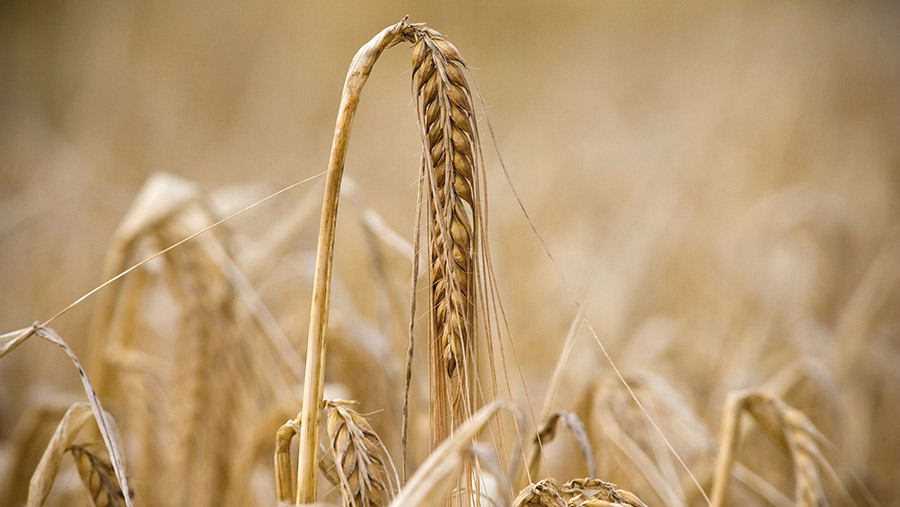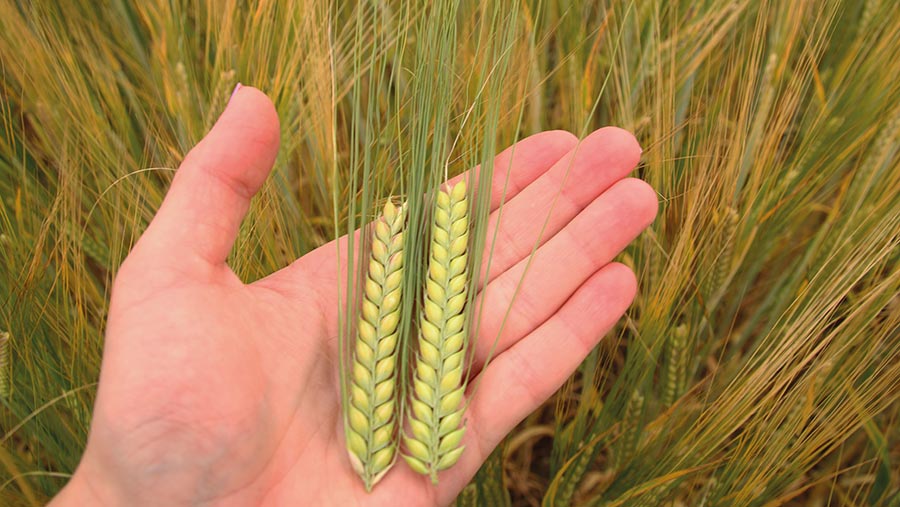Why spring barley can help growers cut their carbon footprint
 © Tim Scrivener
© Tim Scrivener Spring barley can help growers drive down their carbon footprint by using better varietal genetics and using the benefits of cover crops.
Spring crops, in general, are seen as better than autumn-sown ones at carbon and nutrient recycling.
Neil Fuller, independent soil and carbon specialist, says new spring barley varieties give high performance, are very efficient nitrogen users, perform better in drought than older varieties, and are ideal for low-input, high-output systems.
Cover crops, especially legume-based ones, are well suited to suppling following spring crops with nutrients, taking the pressure off synthetic nitrogen fertiliser. This helps to cut the loss of nitrogen in the soil.
“Spring barley brings a high focus on decarbonisation, and good varieties plus good agronomy equals a good carbon outcome,” he tells Farmers Weekly.
See also: Major maltster sees potential in new spring barley for Scotland
Carbon footprint
In terms of malting barley, some 30% of the carbon footprint of beer comes from the production of the grain, and to achieve net zero, Mr Fuller says better varieties, crop rotations and soils, along with cover cropping, will help.
“Greater yield potential allows the carbon burden carried by each tonne of grain to be diluted and the carbon dioxide output per calorie of energy produced to be significantly reduced,” he adds.
Cover crops can boost soil organic matter, improve rooting, help suppress weeds and lower herbicide use, reducing the need for “steel and diesel”.
Some spring barley growers have cut their nitrogen use by 50-75% by taking this soil-focused approach, says Mr Fuller.
With better crop genetics seen as essential in unlocking this sustainability equation, there is early interest in new spring barley malting varieties, such as Curtis, which may help with this process and also make the malting industry less reliant on number one variety, Laureate
Curtis, from plant breeder KWS, was a new entry to the 2023-24 AHDB Recommended List announced at the end of last year, and shows some advantages in terms of yield and straw stiffness over Laureate.
However, it still awaits full approval by the maltsters and distillers.

KWS Curtis © KWS
Maltster’s view
Mark Ineson, grain supply chain manager at maltster Muntons and chairman of the UK malting barley committee (MBC), says new spring barley varieties are urgently required to unlock the future potential of the crop as new investment is being ploughed into the malting industry.
“One of the biggest worries we currently have is the market’s reliance on Laureate, which accounts for nearly 60% of all malting barley produced in Scotland.
“It’s a high-risk situation and it would only take a breakdown in something like disease resistance to severely affect the whole of the UK’s malting barley production. We urgently need new varieties to address this,” he says.
The UK malting market has stayed relatively static, purchasing 1.8m-1.9m tonnes of barley in recent years to produce about 1.5m tonnes of malt annually.
The dual-purpose Laureate, which can be used for brewing or distilling, accounted for 35% of the UK spring barley harvest in 2022.
The variety Curtis is currently entering MBC evaluation and commercial distilling trials, and Mr Ineson says it looks good and certainly ticks all the boxes on paper and in the trials he has seen so far.
“By the time Curtis hits big market share, Laureate will have been around for 10 years, which is where varieties start to tail off, and there is no other variety in the availability position of Curtis,” he adds.
Good straw strength
Adam Christie, managing director of crop consultant Scottish Agronomy, says the variety looks very good, with a particularly good straw strength, but adds its success will depend on end-user acceptance from the distillers and maltsters.
The variety’s yield at 103% for the northern region in the latest Recommended List is only a touch above Laureate at 102%, but its straw strength (8) could be an advantage over Laureate (6) on a 1-9 scale where a high figure indicates the character to a high degree.
“Curtis, because of its standing power, could do well in north-east Scotland, across Moray, Aberdeenshire and north Angus. Land that may have struggled to keep Laureate on its feet may like Curtis,” he says.
The variety has similar strong disease resistance scores to Laureate, with a 9 for mildew and 7 for the all-important wet-weather disease rhynchosporium, which Mr Christie says is key as Scottish spring barley growers are increasingly using just one fungicide at T2, and no T1.
Financially, the new variety could stack up well against winter wheat, with Scottish Agronomy’s own figures showing a gross margin of £559/ha for continuous wheat and £865/ha for malting spring barley.
Carbon dioxide output
Kirsty Richards, cereals product manager at the variety’s breeder, KWS, says AHDB and KWS trials have shown the variety’s combination of high field yields and spirit yields means every 1,000 litres of alcohol results in 120kg less carbon dioxide being produced than with Laureate.
In brewing, Curtis had a carbon dioxide output 10% less than specialist brewing variety Planet for the same hot water extract, she adds.
“This means Curtis offers significant potential across the board, from higher yields and quality for growers to higher alcohol yields from every tonne of grain for distillers and lower carbon dioxide production to help mitigate against climate change,” says Dr Richards.
In the field, the variety has a top 9 rating for resistance to brackling, where weakness at the neck of the barley head can lead it to fall to the ground, against Laureate’s 8, and Curtis is a touch shorter in the straw than Laureate.
Curtis has a similar maturity to Laureate.
Curtis is now undertaking macro malting trials and a decision on provisional or full recommendation by the MBC is set to come in in May/June 2024.
The breeder has two new varieties in the pipeline which could join the Recommended Lists at the end of this year. Nelis is being evaluated as a dual-purpose variety and Premis for brewing only.
Comparison of Curtis and Laureate spring barleys |
||
| Variety | Curtis | Laureate |
| Fungicide-treated yield: UK | 104% | 103% |
| Fungicide-treated yield: North | 103% | 102% |
| Untreated yield | 93% | 94% |
| Specific weight (kg/hl) | 67.5 | 67.2 |
| Nitrogen content (%) | 1.50 | 1.52 |
| Resistance to lodging* | 8 | 6 |
| Ripening (+/- Planet) | +1 | +1 |
| Resistance to brackling | 9 | 8 |
| Disease resistance* | ||
| Mildew | 9 | 9 |
| Brown rust | 4 | 5 |
| Rhynchosporium | 7 | 7 |
| *On a scale of 1 to 9 where a high figure shows the character to a high degree | ||

